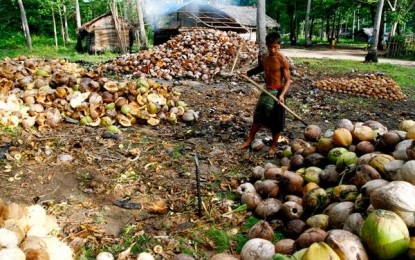
LEAST PRODUCTIVE. A coconut farmer processes coconuts into copra. Coconut farming is one of the least productive economic activities in Eastern Visayas, according to the Philippine Statistics Authority. The sector, which downscaled by 0.5 percent in 2018 from 0.1 percent growth in 2017, contributes 14 percent to the regional economy. (Photo from FB page of Agriculture Secretary Manny Piñol)
TACLOBAN CITY -- The economy of Eastern Visayas grew by 5.9 percent in 2018 due to accelerated performance of services sector, but officials said many residents in the region may not have felt the economic impact as farming sector’s growth continued to dip last year.
Philippine Statistics Authority (PSA) Regional Director Wilma Perante said in a presentation Thursday the region’s performance is up compared to the 1.8 growth recorded in 2017 as the services sector accelerated to 10.5 percent last year.
The service sector accounts for 44.4 percent of the regional economy. About 53 percent of the region’s labor force is employed by service providers.
The National Economic and Development Authority (NEDA) said the proliferation of hotels, restaurants, and other establishments in the region’s major cities contributed to the service sector’s improvement.
“The growth in services can be credited to more flights and passengers -- flights increased by more than 28 percent and passengers by around 25 percent. Weight of annual domestic cargo and cargo throughput also went up -- cargo by almost 22 percent. This is a sign of an active trade in the region,” NEDA Regional Director Meylene Rosales said.
The industry sector, with a share of 41.6 percent to the Gross Regional Domestic Product (GRDP), rebounded from 1.8 percent decline to 3.5 percent growth in 2018. The sector’s recovery can be attributed to better performance of mining and quarrying, which grew by 84.7 percent.
Industrial firms’ workers only account 15.1 percent of the total persons employed, but their output is about eight times more than those hired by farming and fishing-related business ventures and service providers.
Agriculture, hunting, forestry, and fishing went down by 0.5 percent in 2018 from 0.1 percent growth in 2017. The sector contributed 14 percent to the regional economy last year.
“Agriculture and forestry slowed down to 1.1 percent from the 2.8 percent growth in 2017. Fishing continued to decline by 7.4 percent, although at a slower rate than the 10.1 percent contraction in 2017,” Perante said.
Rosales said the farming and fishing sector’s performance is a “letdown” due to limited productivity and dwindling fish catch.
“This could be traced further to weather disturbances, including excessive rainfall. This resulted in delayed planting by farmers. In addition, pest infestations, and the rising fuel prices that led to a reduced number of fishing trips, among others, also adversely affected the sector,” Rosales said.
Rosales explained the declining share of the farming sector is alarming since 31.5 percent of workers in the region are dependent on the sector. Majority of the region’s land is devoted to agriculture development.
The region’s per capita GRDP went up to PHP38,598 in 2018 from PHP37,121 in 2017. This level, the third lowest in the country, is very much lower than the national average of PHP86,370.
Last year’s GRDP growth is within the 5.8 percent to 5.9 percent growth forecast set under the 2017-2022 Regional Development Plan, according to NEDA.
GRDP measures the value of goods and services produced by a region. The figure of all regions sums up to the gross domestic product of a country. (PNA)
